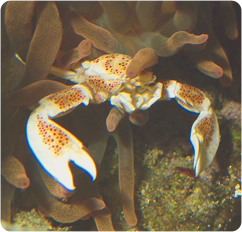|
Life on the Reef - Symbiotic Crabs
Small Crabs Big on Behavior  Many aquarists are familiar with symbiotic shrimp, especially those from the genera Alpheus and Synalpheus, which readily pair up with many gobies from the genera Amblyeleotris and Stonogobiops, but there are many other symbiotic invertebrates worth keeping. This article will look at some symbiotic crabs that can be kept in the marine aquarium. Many aquarists are familiar with symbiotic shrimp, especially those from the genera Alpheus and Synalpheus, which readily pair up with many gobies from the genera Amblyeleotris and Stonogobiops, but there are many other symbiotic invertebrates worth keeping. This article will look at some symbiotic crabs that can be kept in the marine aquarium.
Crabs are crustaceans known as decapods (they have ten legs), and while some are feared by aquarist for the havoc they can wreak on other livestock, many of the smaller symbiotic crabs make fantastic additions to almost any reef aquarium. For example, crabs from the families Trapeziidae, Majidae and Porcellanidae are interesting to watch and, with the right husbandry, pose very little risk to other livestock in your aquarium and, potentially, offer tremendous benefit.
Family Trapeziidae
While often difficult to obtain directly through the aquarium trade, coral crabs from the Family Trapeziidae (e.g., genus Trapezia), sometimes come as hitchhikers on Pocillopora, Acropora and Stylophora coral specimens. Should you remove these symbiotic crabs or leave them? Absolutely leave them. While the relationship is still not fully understood, it has become clear to marine scientists that these coral crabs are not parasitic. In fact, in the wild it is believed that coral crabs provide a benefit to the coral specimen by protecting it from predators such as the crown of thorns starfish (Acanthaster planci). In addition, some researchers have hypothesized that coral crabs provide other benefits to the coral such as helping to fertilize the animal’s zooxanthellae by releasing nitrogen-rich ammonia.
Family Majidae
The spider and decorator crabs of the Family Majidae are fairly common in the marine aquarium trade, especially species from the genus Mithrax. Mithrax cinctimanus, commonly known as the banded clinging crab, readily hosts in anemones such as Condylactis gigantean. As with most anemone crabs, it is unclear whether there is significant benfit to the anemone as a result of this relationship, but the crab itself certainly benefits by the protection afforded by its host. Also within the Family Majidae, crabs from the genus Achaeus (e.g., Achaeus japonicas, commonly called the orangutan crab) are known to live symbiotically with various corals such as Euphyllia and Plerogyra species.
Family Porcellanidae
Of all the symbiotic crabs, the so-called porcelain anemone crabs from the family Porcellanidae are perhaps the best known to aquarist. In particular, crabs from the genus Neopetrolisthes are easy to obtain and make great reef inhabitants. These peaceful crabs will establish a territory within an anemone and prefer to live in pairs. If the anemone is already hosting one or more clownfish, the clownfish and porcelain anemone crab may compete for territory (the crab rarely wins). Like other symbiotic crabs that associate with anemones, it appears the crab benefits more from the relationship than the anemone, although the anemone certainly does not suffer.
Published 8 September 2008. © Blue Zoo Aquatics
|